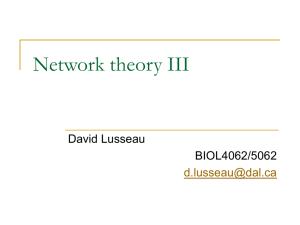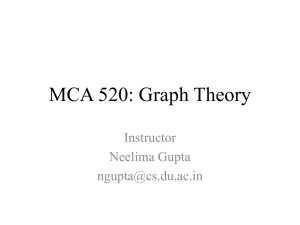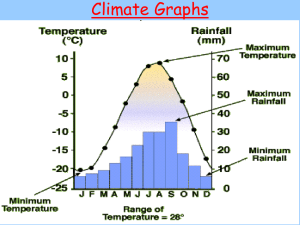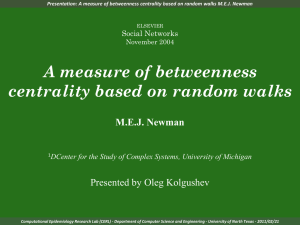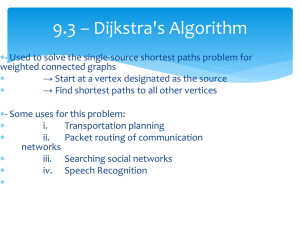Community Detection
advertisement
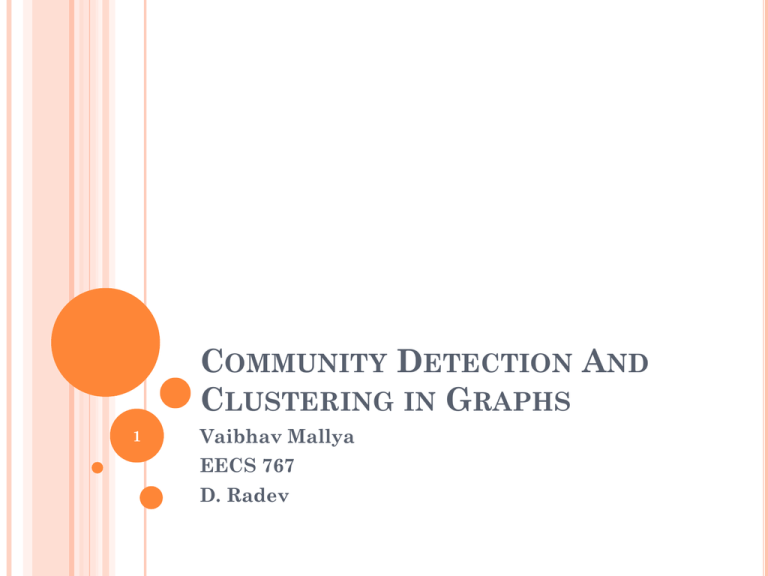
COMMUNITY DETECTION AND CLUSTERING IN GRAPHS 1 Vaibhav Mallya EECS 767 D. Radev AGENDA Agenda Basic Definitions Girvan-Newman Algorithm Donetti-Munoz Spectral Method Karypis-Kumar Multi-level Partitioning Graclus GraphClust 2 DEFINITIONS Complex networks: Study of representations of interactions between real-world entities Borrows heavily from classical graph theory Vertices, nodes, entities connected by links, edges, connections 3 DEFINITIONS (CONT.) Community: One of many (possibly overlapping) subgraphs Has strong internal node-node connections Weaker external connections Community detection algorithms stress high internal connectivity and low external connectivity with a given community Cluster: See community 4 DEFINITIONS (CONT.) Practical applications of clustering, community detection Simplifies visualization, analysis on complex graphs Search engines – Categorization Clusty.com was an early one, is still around Social networks - Useful for tracking group dynamics Neural networks - Tracks functional units Food webs - helps isolate co-dependent groups of organisms 5 GIRVAN-NEWMAN ALGORITHM Published by Michelle Girvan and Mark Newman in 2002 Helped rekindle recent interest in community detection Iteratively finds community boundaries Hierarchical divisive algorithm 6 GIRVAN-NEWMAN ALGORITHM Calculate edge-betweenness for all edges Remove the edge with highest betweenness Recalculate betweenness Repeat until all edges are removed, or modularity function is optimized (depending on variation) 7 GIRVAN-NEWMAN ALGORITHM Quality Function: Objective measure of how good community divisions are Girvan-Newman Modularity is most popular quality function Premise: Random graph has no communities Create a null model of the original graph – similar to actual graph, but without communities. May involve, f.ex randomly rewiring certain nodes while maintaining their degree Hereafter referred to simply as “modularity” 8 GIRVAN-NEWMAN ALGORITHM Modularity equation (Obviously, we can try and optimize this function directly; there are other approaches that do this) 9 GIRVAN-NEWMAN ALGORITHM Vertex Betweenness Centrality First proposed by Freeman Classical vertex importance measure on a network Defined as the total number of shortest paths that pass through each vertex on the network There is a possible ambiguity with this definition 10 GIRVAN-NEWMAN ALGORITHM See it? B A E C D 11 GIRVAN-NEWMAN ALGORITHM To resolve: We’re actually calculating all-shortest paths between two paths There are N paths between any two vertices B Each path gets a weight equal to 1/N A E C D 12 GIRVAN-NEWMAN ALGORITHM Vertex betweenness of C: D-B E-B C-B A-B =2 +0.5 +0.5 +1 +1 B A E C D 13 GIRVAN-NEWMAN ALGORITHM Edge betweenness centrality G-N’s generalization of vertex betweenness Number of shortest paths that pass through a given edge “If there is more than one shortest path between a pair of vertices, each path is given equal weight such that the total weight of all the paths is unity” 14 GIRVAN-NEWMAN ALGORITHM Edge Betweenness example - EA D-B E-B E-A = +0.5 +0.5 +0.5 1.5 B A E C D 15 GIRVAN-NEWMAN ALGORITHM Algorithm for all-edge betweenness Choose two vertices Calculate all shortest paths between these two vertices Place every path encountered into a set Iterate over the set Increment the betweenness of every path by 1 / size of the set Repeat for every pair of vertices 16 GIRVAN-NEWMAN ALGORITHM Intuitively, why should this work? Analogy: Network of N nodes: nodes are towns, edges are roads Place N-1 cars on each node; each one to a town Each road gets a point when a car drives on it Remove the highest ranked road – interstate highway Repeat the process First we’ll remove all interstates (leaving state roads) Then state roads will be removed, leaving county roads, then suburban roads, etc After we each set of levels, we get a more fine-grained division of communities 17 GIRVAN-NEWMAN COMPLEXITY Original definition for undirected graphs More on possible directed generalizations later O(mn), or O(n^2) on sparse graph 18 GIRVAN-NEWMAN OUTPUT Chesapeake Bay Food Web 19 GIRVAN-NEWMAN OUTPUT Santa Fe Institute Collaboration Network 20 GIRVAN-NEWMAN OUTPUT Zachary’s Karate Club 21 DONETTI-MUNOZ SPECTRAL METHOD Based on eigenvectors of the Laplacian matrix “Elegant insight” For any two nodes A and B, these eigenvector components will be very close Convert into coordinates: points in an M-dimensional metric space M corresponds to number of eigenvectors used Then we can apply standard clustering techniques Manhattan distance, angle distance, etc Apply basic hierarchical clustering methods after conversion; merge connected cluster pairs 22 DONETTI-MUNOZ SPECTRAL METHOD Laplacian Matrix (aka Kirchhoff matrix) “L” Encodes topological information Symmetric N x N Each diagonal “i” corresponds to degree of vertex “i“ Other elements = -1 edge exists between row and column, 0 otherwise Useful properties 23 DONETTI-MUNOZ SPECTRAL METHOD Example Laplacian A B C D E A 2 -1 0 0 -1 B -1 2 -1 0 0 C 0 -1 2 0 -1 D 0 0 0 1 -1 E -1 0 -1 -1 3 B A E D C 24 DONETTI-MUNOZ SPECTRAL METHOD Calculation of Laplacian’s eigenvectors is bottleneck Use Lanczos method to determine best ones Runtime: O(Number of edges / (difference between two smallest eigenvalues) ) 25 DONETTI-MUNOZ SPECTRAL METHOD Lanczos Method Iterative algorithm for approximating eigenvalues of a square matrix Improves on power-law method – retain intermediate eigenvalues Generates tri-diagonal matrix whose eigenvectors are calculated cheaply Must balance round-off errors, which accumulate – numerical stability is complicated but manageable 26 DONETTI-MUNOZ SPECTRAL METHOD Applied to Zachary’s Karate Club Network Circles/squares = original, colors = additional 27 DONETTI-MUNOZ SPECTRAL METHOD Applied to computer-generated random graphs 28 KARYPIS-KUMAR MULTI-LEVEL PARTITIONING Example of multi-level partitioning scheme 1) 2) 3) Coarsen: Reduce graph in some meaningful way, collapsing vertices and edges Partition: Calculate good partition Uncoarsen: Obtain something resembling the original graph, with partitions intact. Key advantage of such schemes is speed Partitions tend to be of slightly worse quality But the algorithm is significantly faster 29 KARYPIS-KUMAR MULTI-LEVEL PARTITIONING Karypis-Kumar based their algorithm on Hendrickson-Leland collapsing approach Heavy Edge Matching for partitioning Improved Kernigan-Lin for partition refining 1) Coarsen: Collapse a pair of adjacent vertices 1) 2) 2) Creates multinode of the vertices They use “maximal matchings” to include maximum possible number of collapsed edges Partition: Compute a high-quality bisection 1) 2) Cut the graph in a meaningful way KL, SB, GGP, GGGP 30 KARYPIS-KUMAR MULTI-LEVEL PARTITIONING 3) Uncoarsening: Expand the smaller graph back into the original via boundary KL method 1) 2) The graph is uncoarsened in stages At each stage, the partition is corrected 31 KARYPIS-KUMAR MULTI-LEVEL PARTITIONING The graph that shows their algorithm is better Compared to MS Bisection algorithm. 32 KARYPIS-KUMAR MULTI-LEVEL PARTITIONING Another graph showing their algorithm is better 33 GRACLUS Software for calculating partitions, clusters Avoids use of eigenvector-based schemes Uses novel algorithms developed at UT Austin Eigenvectors are Expensive to compute Key idea: Finding graph clusters equivalent to maximizing weighted kernel k-means objective function 34 GRACLUS Like Karypis-Kumar, multi-level Coarsening: Yu-Shi algorithm, a kind of spectral method 35 GRACLUS Refinement 36 GRACLUS Refinement – Objectives, Kernel Matrix to use 37 GRACLUS 38 GRACLUS Harry Potter 39 GRAPHCLUST Shasha et al, primarily from NYU “Clusters graphs based on topology” Clusters a *set* of graphs Clusters a graph based on four dimensions: Substructure definition Graph type Distance Metric Number of Clusters 16 algorithms; each dimension has 1 option. 40 GRAPHCLUST For each graph Record the number of times each substructure is present Construct a vector of non-negative integers Use the provided distance metric (inner dot product or Euclidean distance) to cluster the graph. Intended to work on *database* of graphs, potentially thousands of them or more Algorithm is supposed to be fast Can optionally use SVD for added speed 41 LIST OF SOURCES A fast and high quality multilevel scheme for partitioning irregular graphs G. Karypis and V. Kumar, 1998 Community structure in social and biological networks (Girvan-Newman, 2002) http://www.pnas.org/content/99/12/7821 A Fast Kernel-based Multilevel Algorithm for Graph Clustering, I. Dhillon, Y. Guan, and B, Kulis, 2005 http://www.acm.org/sigs/sigkdd/kdd2005/index.ht ml 42 LIST OF SOURCES (CONT.) Modularity and community structure in networks (Newman, 2006) Community Detection Algorithms: A comparative analysis by Lancichinetti and Fortunato, 2009 Community detection in graphs by Fortunato, 2009 43

